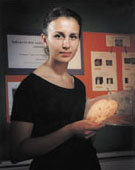
Students' Software Aids Brain Mapping
By Victoria White
Quick: Name three different kinds of birds.
As your mind rattles off eagle, parrot and blue jay, or robin, parakeet and woodpecker, a portion of your brain’s cerebral cortex fires into action. But exactly where in the brain are thoughts and actions processed?
A new software program developed by University of Florida doctoral student Didem Gökçay with assistance from doctoral student Cécile Mohr helps researchers pinpoint the precise components that work together to perform a variety of brain activities. Eventually, such precision mapping is expected to help make brain surgery more exact and improve rehabilitation of people with brain disease or injury.
The program, whose development was supported by a grant from the National Institutes of Health, is called LOFA — for localization of functional activity. It eases the interpretation of functional magnetic resonance images — scans that identify changes in blood oxygen levels in the brain as a person performs specific tasks.
"LOFA really helps us get a better idea of how brain systems are put together," said Bruce Crosson, a professor of clinical and health psychology in UF’s College of Health Professions who has used the software in his research. "We’ve been able to determine the precise locations of brain structures involved in language initiation. We can see, too, how those sections fit in with the cognitive, motor and emotional areas of the brain.
"In the long run, that kind of knowledge should help us design better strategies for rehabilitation following brain injury or disease. And it could help map a person’s brain functions before surgery to avoid areas of cortex that control important activities," said Crosson, who is affiliated with UF’s multidisciplinary Brain Institute.
Mohr, a doctoral student in UF’s medical physics program in the nuclear and radiological engineering department, said a tool like LOFA is needed because researchers are now exploring much more subtle questions than in the past.
"We’re beyond trying to figure out where the visual, auditory and motor areas are located in the brain," Mohr said. "Scientists know that. Now we’re asking questions about the connectivity of the brain and trying to find out the anatomic structures that correlate with functions. For that, we need to be very precise and LOFA helps us do that."
During the past few years, fMRI has become an increasingly popular research tool, as scientists worldwide seek a better understanding of what the brain is doing as it processes information, thinks and controls movement. Standard MRI scans provide a look at the physical structure of the brain. In contrast, fMRI scans show areas of brain activity, which can be overlaid on anatomical pictures to map where the activity is occurring.
But precisely delineating the activity has been difficult because of the nature of the cerebral cortex, which varies substantially from person to person.
"The cerebral cortex is a crumpled structure made up of bumps and grooves," said Gökçay, a doctoral student in computer and information sciences who conducted her research at UF’s Brain Institute. "Think of frying a piece of bacon or crumpling a piece of paper. The results will look different each time. The crumples across brains are not the same, and their shapes and sizes can be very different as well."
Gökçay sought to develop a program that would make it easy to trace the sulci (the grooves of the cortex), because two-thirds of the brain function is buried within them. She also wanted users to have the option to include nearby structures in the region they were exploring, because activity in neighboring sites can offer additional information about function.
Gökçay’s program provides researchers with an easy, flexible tool for tracing sections of the twisting, turning, three-dimensional cortex that is of interest. The users can delve deep within the grooves of the cortex and combine results from multiple areas, which is difficult to do with other software.
Didem Gökçay
didem@cis.ufl.edu